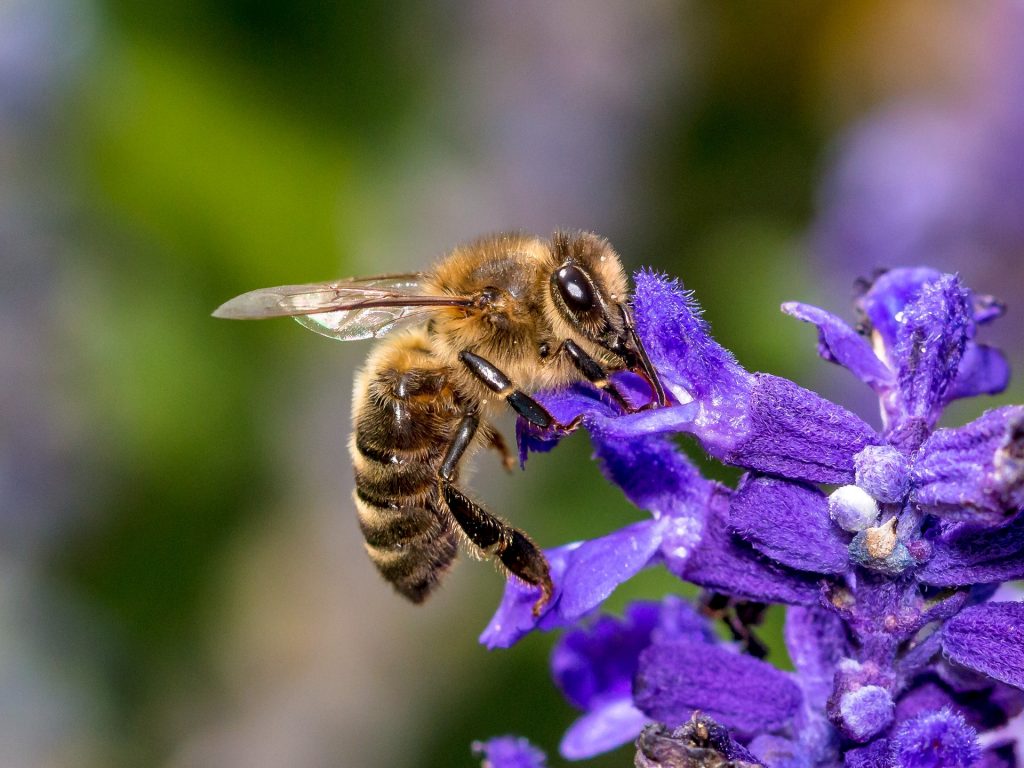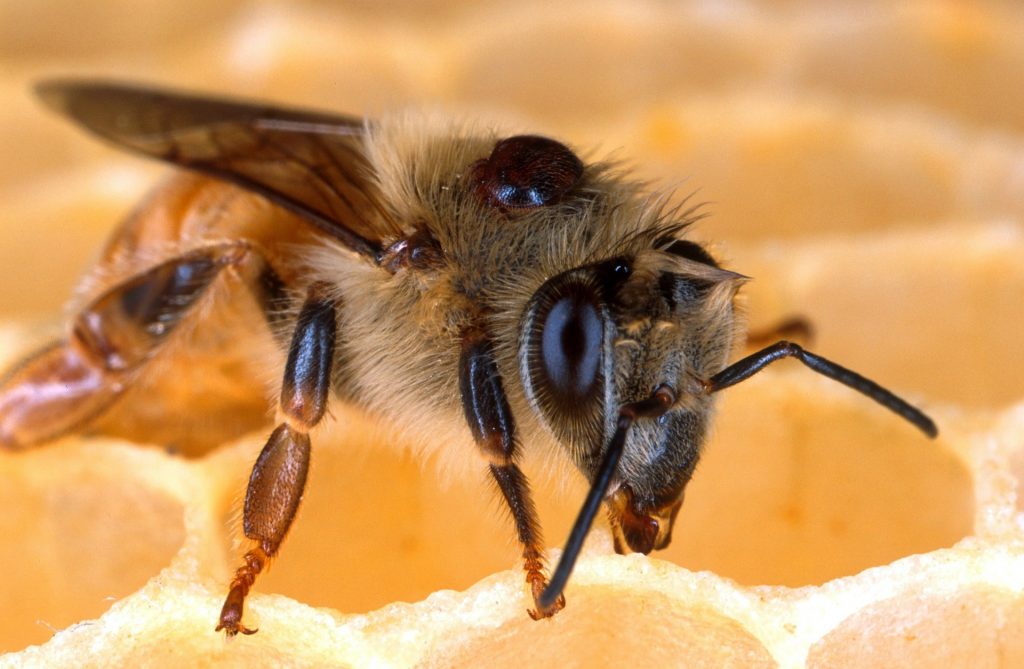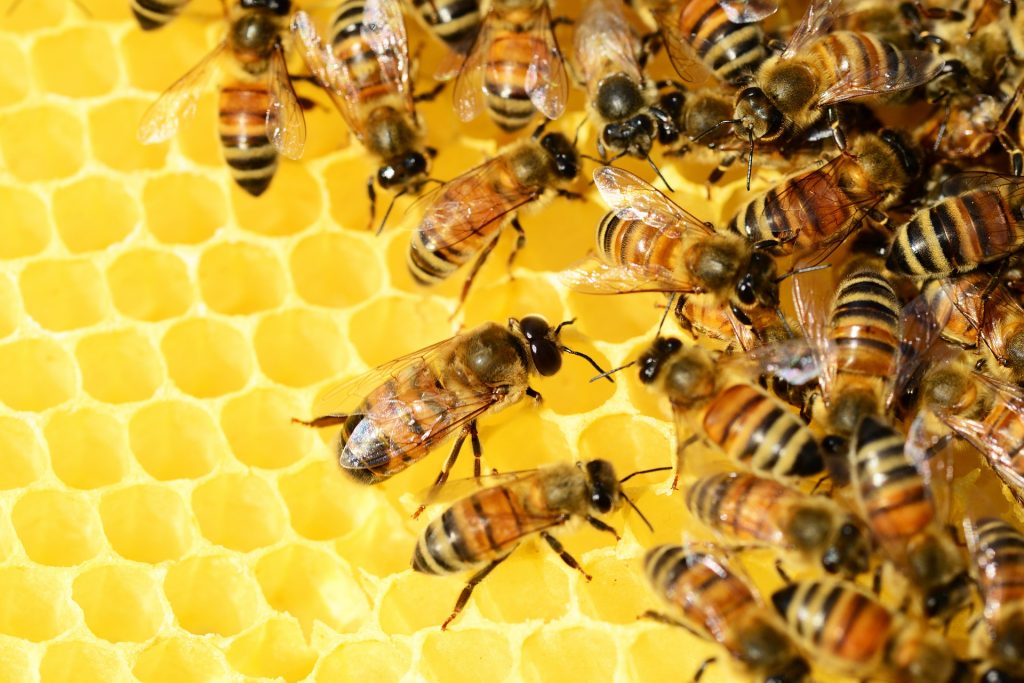
After we have already published an article about wasps, we don’t want to neglect the bees and dedicate a new report to them as well.
Nowadays, bees and their services for natural diversity and the ecosystem are on everyone’s lips. In short: without these enchanting creatures, we humans would have a big problem.
In the following feature, we will focus on the bees and highlight how diligent and fascinating these workers are. Honeybees can even dance!
How bees contribute to a functioning ecosystem?
The world of flowering plants has developed for many thousands of years together with pollinating insects, so both are interdependent.1 Only a few trees and grasses (including rice, wheat, rye and barley) can survive without pollinators, as for these plants the wind is sufficient for pollination.2
Regardless of the size, colour and social behaviour of the bees, they pollinate an enormous quantity of plants which are of great importance to us humans. The bee has evolved into a significant pollinator in the world.3
Likewise, the delicious honey that honeybees produce has become an integral part of our diet. But it also serves as food for the bees themselves, especially in times of unfavourable weather.1
And we don’t want to forget that bees are a popular source of food for many animals (e.g. birds, spiders etc.).4
What dangers do bees pose to humans?
You can be stung. However, since bees are very peaceful creatures and give their life for a sting, it is only used for self- defence, for example to protect their hive from honey and brood predators.5
But the real question is: What dangers is the bee exposed to nowadays?
The underlying reasons as to why whole bee populations die are complex and discussed controversially among experts. However, it is agreed that the combination of several factors cause disproportionate mortality rates. Still, there is consensus among experts that a healthy bee colony is usually able to cope with most diseases.6
Here we describe some main dangers of the bees:
- Varroa mite: This mite is a parasite of adult bees, as well as larvae and nymphs. It causes the “varroa-mite disease”, which is one of the leading causes of worldwide bee mortality. The varroa mite hatches shortly before capping in honeycomb cells, where larvae grow into nymphs and lay their eggs. Then the mite and its offspring feed on the blood of the bees. This small pest looks like a flat crab (miniature, approx. 1.7 mm in size) and causes severely misshaped bees. It often clings to the body of drones, workers and queens to suck their blood and can transmit a virus that can be fatal to the bee.7

- Pesticides: The widespread use of pesticides in open land and nature like in agriculture is another contributing factor. The cause-effect of many chemicals is not yet clear, but it is known that even the smallest amounts of pesticides can attack the nervous system of bees and affect their orientation, preventing them from returning to their hive.6 In contrast to the past, pesticides today are more targeted and subject to stringent regulations. Nevertheless, they must be used correctly and in accordance with the approved conditions to avoid adverse effects on the ecosystem, including bees, or human health.8
- Nutrition: The bee lives, like we humans do, from a versatile nutrition. The more varied the food supply, the more resistant the bees are to diseases. The intensive use of the cultural landscape and the increasing development of monocultures reduce the diversity of habitats. If all nectar suppliers flower simultaneously and only for a short time, the remaining months become a starvation period for the animals. To prevent bees from starving (to death), they are dependent on varied habitats with an abundant supply of flowering plants all year round.6
- Climate change: Climate change is disrupting the rhythm of bees, whereas changes in temperature seem to cause the most severe effects as it alters the time of spring awakening to various extents, depending on the species. As a consequence temporal mismatches between bee and plant species occur. If the bees hatch too early at the beginning of spring, they might face a scenario, where they will have to survive without plants for a long time. And what does a bee do without food?9
In addition, too rainy springs and too dry summers are dangerous for bee colonies, as these impair the collecting activities of the workers. When it rains, most of them stay in the hive and intense heat prevents plants from producing nectar. Therefore, in such cases bees have to fall back on their stocks, which are eventually exhausted someday.10
The characteristics and properties of a bee:
There are over 20.000 species of bees worldwide, but only a dozen of them are honeybees that live in colonies.11
Solitary bees make up the largest share. They do not live in a large bee colony, but each female bee uses its short life span exclusively to reproduce, usually creating several nests and providing its offspring with provisions for the development into adult bees.9
A honey-producing bee colony can consist of up to 80.000 individuals.12 In such a “superorganism” every bee has its task:
The mother and thus the center of a state is the queen. Every year, the older queen swarms out with a swarm of bees to find a new home and makes room for the new queen. The young queen is mated by several drones during the so-called wedding flight in order to lay eggs for the rest of her life and thus maintain her hives. She lays up to 2.000 eggs per day and is irreplaceable for the colony. She is supplied around the clock and fed with the well-known royal jelly.13 The queen uses pheromones to control events in the state. It supports the learning behaviour of the workers, suppresses the development or rearing of new queens and attracts drones during the mating season. A queen can live up to 5 years.14
Reproduction is the drone’s only job. Several hundred hatched drones meet at so-called drones gathering places and wait for queens from the surrounding area, which set out for the wedding flight. Inbreeding is avoided, only drones from other bee colonies get the opportunity to mate with the young queen. Since only about 10 to 15 male bees play a role in the process, the chance for an individual drone is relatively low. For the ‘successful’ drones, the pleasure is also only of short duration, because after the sperm donation they die. All other colleagues remain then still some time in the beehive until they are “expelled” after a grace period of approx. 30 days. Since they are no longer used for reproduction, the workers deny them access to the beehive, deny them food, or (in rare cases) stab them dead with their sting.15
Most of the bees in a hive are the workers. They live up to their name and, depending on their age, take over all important tasks in the hive. Young bees stay “at home” for up to three weeks, clean cells, remove nectar and pollen from the collecting bees, feed the offspring with them, build new wax combs and regulate the temperature and humidity in the beehive until they finally become guards at the hive entrance. During the second half of their life, in summer their lifespan is about 6 weeks, they are primarily bees that collect nectar, pollen and water from their surroundings.14
Does BIO/CLEAN KILL harm bees?
If BIO/CLEAN KILL is used as described on the label, no bees will be harmed. These insects move in the wild, on plants and flowers where BIO/CLEAN KILL is not used, so this product is no danger for bees. As a biocide, BIO/CLEAN KILL is intended for use indoors or around buildings under eaves. It should not and must not be used on plants or flowers.
And finally, a few cool facts:
- Bees can heat and cool the hive. They tremble to generate heat or cool the hive with flapping wings.16
- Workers give their colleagues tips on where to find good food sources in the area. To describe the direction, distance and quality of the feeding places, they dance eight-shaped figures on the honeycombs, also known as wagging dance.17
- Bees produce 6 different substances:
Honey, perga (“bee bread” from pollen for the brood), wax, propolis (mainly extracted from tree resin, kills microorganisms), royal jelly (food for the existing and growing queen) and bee venom.11 - Eastern honeybees have developed a strategy to defend themselves against Asian giant hornets. The heat ball. The attacker is encircled by workers in a spherical shape and then the temperature is raised by shaking the wing muscles. The hornet dies of overheating.18
To save bees and offer them more beautiful habitats, there are some tips and ideas. We invite you to dive even deeper into the world of bees. If you get to know the small animals better, you will understand that you don’t have to be afraid of them. Bees are peaceful creatures that work all their lives and thus contribute significantly to a functioning ecosystem. We should thank them for this by keeping them alive and possibly setting up a bee hotel in your garden. And the honeybees will certainly be happy if you buy their honey from the local beekeeper, because the liquid gold is a quality product and has its Price.

Click here to see: WORLD OF BEES – REFERENCES